GSK-3 Inhibitor Elraglusib Enhances Tumor-Infiltrating Immune Cell Activation in Tumor Biopsies and Synergizes with Anti-PD-L1 in a Murine Model of Colorectal Cancer
Abstract
1. Introduction
2. Results
2.1. Elraglusib Sensitizes Tumor Cells to Immune-Mediated Cytotoxicity
2.2. Elraglusib Enhances Tumor Cell Pyroptosis in a Co-Culture of Colorectal Cancer Cells and Immune Cells
2.3. Elraglusib Upregulates Tumor Cell PD-L1 and Proapoptotic Pathway Expression as Well as Downregulates Immunosuppressive/Angiogenic Protein Expression and Pro-Survival Pathways
2.4. Elraglusib Enhances Immune Cell Effector Function
2.5. Elraglusib Significantly Prolongs Survival in Combination with Anti-PD-L1 Therapy in a Syngeneic MSS CRC Murine Model
2.6. Murine Responders Have More T Cell Tumor-Infiltration and Elevated Tumoral CD8+/Treg and CD4+/Treg Ratios
2.7. Murine Responders Show an Immunostimulatory Tumor Microenvironment by IHC
2.8. Murine Responders Have Reduced Tumorigenic and Elevated Immunomodulatory Cytokine Concentrations
2.9. Patient Plasma Concentrations of Cytokines from a Phase 1 Clinical Trial Investigating Elraglusib Correlate with Progression-Free Survival, Overall Survival, and In Vivo Response to Therapy Results
2.10. PanCK+ Expression of Immunosuppressive CD39 Negatively Correlated with Time-on-Treatment (Tx time) While CD45+ Expression of Monocyte/Macrophage Marker CD163 Positively Correlated with Tx Time
2.11. Tumor-Infiltrating Immune Cells Have Reduced Inhibitory Checkpoint Expression and Elevated Expression of T Cell Activation Markers after Elraglusib Treatment
2.12. Patients with a Long Time-on-Treatment Have Decreased B Cell and Myeloid Marker Expression in Immune Cell Regions and Have Decreased Immune Checkpoint Expression in Tumor Cell Regions
3. Discussion
4. Methods
4.1. Cell Culture Maintenance
4.2. Measurement of Cell Viability
4.3. Pyroptosis Assay
| Reagent | Source | Identifier | Concentration |
| Vinculin (E1E9V) XP® Rabbit mAb | Cell Signaling | Cat# 13901 | 1:1000 |
| Anti-GSDMB antibody | Sigma-Aldrich | Cat# HPA052407 | 1:1000 |
4.4. Isolation of Donor-Derived CD8+ T Cells
4.5. Collection of Cell Culture Supernatants Used in Cytokine Measurements
4.6. Human Cytokine Profiling
4.7. Murine Cytokine Profiling
4.8. GFP+ Cell Line Generation
4.9. Multicolor Immune Cell Co-Culture Experiments
4.10. Single-Color Immune Cell Co-Culture Experiments
4.11. Generation of Single-Cell Suspensions
4.12. Flow Cytometry
| Reagent | Source | Identifier | Concentration |
| Zombie Violet™ Fixable Viability Kit | BioLegend | 423114 | 1:1000 |
| CD45 Monoclonal Antibody (30-F11), eVolve 605 | eBioscience™ | 83-0451-42 | 5 µL/test |
| PE Rat Anti-Mouse CD3 Molecular Complex, Clone 17A2 (RUO) | BD Biosciences | 555275 | 0.125 µg/test |
| CD335 (NKp46) Monoclonal Antibody (29A1.4), APC | eBioscience™ | 17-3351-82 | 0.125 µg/test |
| APC/Cy7 anti-mouse/human CD11b, clone: M1/70 | BioLegend | 101226 | 0.125 µg/test |
| Cd27 Monoclonal Antibody (LG.7F9), FITC | eBioscience™ | 11-0271-82 | 0.5 µg/test |
| Klrg1 Monoclonal Antibody (2F1), PE-Cyanine7 | eBioscience™ | 25-5893-82 | 0.25 µg/test |
| Anti-mouse CD45, eBioscience, eVolve 605, clone: 30-F11 | Invitrogen | 83-0451-42 | 0.5 µg/test |
| APC-Cy™7 Rat Anti-Mouse CD3 Molecular Complex, clone 17A2 | BD Biosciences | 560590 | 0.125 µg/test |
| CD4 Monoclonal Antibody (RM4-5), PE-Cyanine7 | Invitrogen | 25-0042-82 | 0.25 µg/test |
| PE Rat Anti-Mouse CD8a, Clone 53-6.7 (RUO) | BD Biosciences | 553032 | 0.125 µg/test |
| CD69 Monoclonal Antibody (H1.2F3), FITC | eBioscience™ | 11-0691-81 | 0.5 µg/test |
| FOXP3 Monoclonal Antibody (FJK-16s), APC | Manufacturer | 17-5773-82 | 1 µg/test |
4.13. Natural Killer Cell Immunophenotyping
4.14. T Cell Immunophenotyping
4.15. Western Blot Analysis
| Reagent | Source | Identifier | Concentration |
| PARP Antibody | Cell Signaling | Cat# 9542S | 1:1000 |
| Mcl-1 (D2W9E) Rabbit mAb | Cell Signaling | Cat# 94296S | 1:1000 |
| NF-κB p65 (L8F6) Mouse mAb | Cell Signaling | Cat# 6956 | 1:1000 |
| PD-L1 (E1L3N®) XP® Rabbit mAb | Cell Signaling | Cat# 13684 | 1:1000 |
| Bcl-2 (D55G8) Rabbit mAb | Cell Signaling | Cat# 4223S | 1:1000 |
| Survivin (71G4B7) Rabbit mAb | Cell Signaling | Cat# 2808S | 1:1000 |
| Mouse Anti-Ran | BD Biosciences | Cat# 610341 | 1:5000 |
| NIK Antibody | Cell Signaling | Cat# 4994 | 1:1000 |
4.16. In Vivo Studies
4.17. Immunohistochemistry
| Reagent | Source | Identifier | Concentration |
| CD4 (D7D2Z) Rabbit mAb | Cell Signaling | 25229S | 1:200 |
| CD8α (D4W2Z) XP® Rabbit mAb (Mouse Specific) | Cell Signaling | 98941 | 1:800 |
| Anti-TRAIL antibody | Abcam | ab231265 | 20 µg/ml |
| NKp46 (CD335) Polyclonal Antibody | Invitrogen | PA5-79720 | 1 µg/mL |
| FoxP3 (D6O8R) Rabbit mAb | Cell Signaling | 12653 | 1:800 |
| Granzyme B (E5V2L) Rabbit mAb | Cell Signaling | 44153 | 1:200 |
| Ki-67 (D3B5) Rabbit mAb (Mouse Preferred; IHC Formulated) | Cell Signaling | 12202 | 1:800 |
| PD-1/CD279 Polyclonal antibody | Proteintech | 18106-1-AP | 1:1000 |
| PD-L1/CD274 Monoclonal antibody | Proteintech | 66248-1-Ig | 1:5000 |
| Cleaved Caspase-3 (Asp175) Antibody | Cell Signaling | 9661 | 1:400 |
| VEGF Monoclonal Antibody (JH121) | Invitrogen | MA5-13182 | 1:20 |
| TGF beta 2-Specific Polyclonal antibody | Proteintech | 19999-1-AP | 1:500 |
4.18. Microarrays
4.19. Single-Cell RNA Sequencing
4.20. Digital Spatial Profiling
4.21. Clinical Specimens
4.22. Statistical Analysis
Supplementary Materials
Author Contributions
Funding
Institutional Review Board Statement
Informed Consent Statement
Data Availability Statement
Acknowledgments
Conflicts of Interest
References
- Ding, L.; Madamsetty, V.S.; Kiers, S.; Alekhina, O.; Ugolkov, A.; Dube, J.; Zhang, Y.; Zhang, J.S.; Wang, E.; Dutta, S.K.; et al. Glycogen Synthase Kinase-3 Inhibition Sensitizes Pancreatic Cancer Cells to Chemotherapy by Abrogating the TopBP1/ATR-Mediated DNA Damage Response. Clin. Cancer Res. 2019, 25, 6452–6462. [Google Scholar] [CrossRef]
- Force, T.; Woodgett, J.R. Unique and overlapping functions of GSK-3 isoforms in cell differentiation and proliferation and cardiovascular development. J. Biol. Chem. 2009, 284, 9643–9647. [Google Scholar] [CrossRef] [PubMed]
- Zhang, J.S.; Herreros-Villanueva, M.; Koenig, A.; Deng, Z.; de Narvajas, A.A.M.; Gomez, T.S.; Meng, X.; Bujanda, L.; Ellenrieder, V.; Li, X.K.; et al. Differential activity of GSK-3 isoforms regulates NF-κB and TRAIL- or TNFα induced apoptosis in pancreatic cancer cells. Cell Death Dis. 2014, 5, e1142. [Google Scholar] [CrossRef] [PubMed]
- Augello, G.; Emma, M.R.; Cusimano, A.; Azzolina, A.; Montalto, G.; McCubrey, J.A.; Cervello, M. The Role of GSK-3 in Cancer Immunotherapy: GSK-3 Inhibitors as a New Frontier in Cancer Treatment. Cells 2020, 9, 1427. [Google Scholar] [CrossRef]
- Cohen, P.; Frame, S. The renaissance of GSK3. Nat. Rev. Mol. Cell Biol. 2001, 2, 769–776. [Google Scholar] [CrossRef] [PubMed]
- Tsai, C.C.; Tsai, C.K.; Tseng, P.C.; Lin, C.F.; Chen, C.L. Glycogen Synthase Kinase-3β Facilitates Cytokine Production in 12-O-Tetradecanoylphorbol-13-Acetate/Ionomycin-Activated Human CD4(+) T Lymphocytes. Cells 2020, 9, 1424. [Google Scholar] [CrossRef] [PubMed]
- Taylor, A.; Harker, J.A.; Chanthong, K.; Stevenson, P.G.; Zuniga, E.I.; Rudd, C.E. Glycogen Synthase Kinase 3 Inactivation Drives T-bet-Mediated Downregulation of Co-receptor PD-1 to Enhance CD8(+) Cytolytic T Cell Responses. Immunity 2016, 44, 274–286. [Google Scholar] [CrossRef]
- Li, C.-W.; Lim, S.-O.; Xia, W.; Lee, H.-H.; Chan, L.-C.; Kuo, C.-W.; Khoo, K.-H.; Chang, S.-S.; Cha, J.-H.; Kim, T.; et al. Glycosylation and stabilization of programmed death ligand-1 suppresses T-cell activity. Nat. Commun. 2016, 7, 12632. [Google Scholar] [CrossRef]
- Fuchs, S.Y.; Spiegelman, V.S.; Suresh Kumar, K.G. The many faces of β-TrCP E3 ubiquitin ligases: Reflections in the magic mirror of cancer. Oncogene 2004, 23, 2028–2036. [Google Scholar] [CrossRef]
- Mancinelli, R.; Carpino, G.; Petrungaro, S.; Mammola, C.L.; Tomaipitinca, L.; Filippini, A.; Facchiano, A.; Ziparo, E.; Giampietri, C. Multifaceted Roles of GSK-3 in Cancer and Autophagy-Related Diseases. Oxid. Med. Cell Longev. 2017, 2017, 4629495. [Google Scholar] [CrossRef]
- Borelli, B.; Antoniotti, C.; Carullo, M.; Germani, M.M.; Conca, V.; Masi, G. Immune-Checkpoint Inhibitors (ICIs) in Metastatic Colorectal Cancer (mCRC) Patients beyond Microsatellite Instability. Cancers 2022, 14, 4974. [Google Scholar] [CrossRef] [PubMed]
- Gupta, R.; Sinha, S.; Paul, R.N. The impact of microsatellite stability status in colorectal cancer. Curr. Probl. Cancer 2018, 42, 548–559. [Google Scholar] [CrossRef] [PubMed]
- Middha, S.; Yaeger, R.; Shia, J.; Stadler, Z.K.; King, S.; Guercio, S.; Paroder, V.; Bates, D.D.B.; Rana, S.; Diaz, L.A., Jr.; et al. Majority of B2M-Mutant and -Deficient Colorectal Carcinomas Achieve Clinical Benefit From Immune Checkpoint Inhibitor Therapy and Are Microsatellite Instability-High. JCO Precis. Oncol. 2019, 3, 1–14. [Google Scholar] [CrossRef] [PubMed]
- Carneiro, B.A.; Cavalcante, L.; Bastos, B.R.; Powell, S.F.; Ma, W.W.; Sahebjam, S.; Harvey, D.; De Souza, A.L.; Dhawan, M.S.; Safran, H.; et al. Phase I study of 9-ing-41, a small molecule selective glycogen synthase kinase-3 beta (GSK-3β) inhibitor, as a single agent and combined with chemotherapy, in patients with refractory tumors. J. Clin. Oncol. 2020, 38, 3507. [Google Scholar] [CrossRef]
- Rudd, C.E.; Chanthong, K.; Taylor, A. Small Molecule Inhibition of GSK-3 Specifically Inhibits the Transcription of Inhibitory Co-receptor LAG-3 for Enhanced Anti-tumor Immunity. Cell Rep. 2020, 30, 2075–2082.e2074. [Google Scholar] [CrossRef]
- Tang, Y.Y.; Sheng, S.Y.; Lu, C.G.; Zhang, Y.Q.; Zou, J.Y.; Lei, Y.Y.; Gu, Y.; Hong, H. Effects of Glycogen Synthase Kinase-3β Inhibitor TWS119 on Proliferation and Cytokine Production of TILs From Human Lung Cancer. J. Immunother. 2018, 41, 319–328. [Google Scholar] [CrossRef]
- Taylor, A.; Rudd, C.E. Glycogen synthase kinase 3 (GSK-3) controls T-cell motility and interactions with antigen presenting cells. BMC Res. Notes 2020, 13, 163. [Google Scholar] [CrossRef] [PubMed]
- Kaler, P.; Augenlicht, L.; Klampfer, L. Activating Mutations in β-Catenin in Colon Cancer Cells Alter Their Interaction with Macrophages; the Role of Snail. PLoS ONE 2012, 7, e45462. [Google Scholar] [CrossRef]
- Rowan, A.J.; Lamlum, H.; Ilyas, M.; Wheeler, J.; Straub, J.; Papadopoulou, A.; Bicknell, D.; Bodmer, W.F.; Tomlinson, I.P.M. APC mutations in sporadic colorectal tumors: A mutational “hotspot” and interdependence of the “two hits”. Proc. Natl. Acad. Sci. USA 2000, 97, 3352. [Google Scholar] [CrossRef]
- Fischer, M. Census and evaluation of p53 target genes. Oncogene 2017, 36, 3943–3956. [Google Scholar] [CrossRef]
- Zeng, Q.; Huang, Y.; Zeng, L.; Lan, X.; Huang, Y.; He, S.; Zhang, H. Effect of IPP5, a novel inhibitor of PP1, on apoptosis and the underlying mechanisms involved. Biotechnol. Appl. Biochem. 2009, 54, 231–238. [Google Scholar] [CrossRef] [PubMed]
- Mezzadra, R.; Sun, C.; Jae, L.T.; Gomez-Eerland, R.; de Vries, E.; Wu, W.; Logtenberg, M.E.W.; Slagter, M.; Rozeman, E.A.; Hofland, I.; et al. Identification of CMTM6 and CMTM4 as PD-L1 protein regulators. Nature 2017, 549, 106–110. [Google Scholar] [CrossRef] [PubMed]
- Zhang, X.; Huang, X.; Xu, J.; Li, E.; Lao, M.; Tang, T.; Zhang, G.; Guo, C.; Zhang, X.; Chen, W.; et al. NEK2 inhibition triggers anti-pancreatic cancer immunity by targeting PD-L1. Nat. Commun. 2021, 12, 4536. [Google Scholar] [CrossRef] [PubMed]
- Brandt, C.S.; Baratin, M.; Yi, E.C.; Kennedy, J.; Gao, Z.; Fox, B.; Haldeman, B.; Ostrander, C.D.; Kaifu, T.; Chabannon, C.; et al. The B7 family member B7-H6 is a tumor cell ligand for the activating natural killer cell receptor NKp30 in humans. J. Exp. Med. 2009, 206, 1495–1503. [Google Scholar] [CrossRef]
- Zhou, Z.; He, H.; Wang, K.; Shi, X.; Wang, Y.; Su, Y.; Wang, Y.; Li, D.; Liu, W.; Zhang, Y.; et al. Granzyme A from cytotoxic lymphocytes cleaves GSDMB to trigger pyroptosis in target cells. Science 2020, 368, 2–7. [Google Scholar] [CrossRef]
- Huntington, K.E.; Louie, A.; Zhou, L.; El-Deiry, W.S. A high-throughput customized cytokinome screen of colon cancer cell responses to small-molecule oncology drugs. Oncotarget 2021, 12, 1980–1991. [Google Scholar] [CrossRef]
- Honey, K. CCL3 and CCL4 actively recruit CD8+ T cells. Nat. Rev. Immunol. 2006, 6, 427. [Google Scholar] [CrossRef]
- Chou, W.-C.; Rampanelli, E.; Li, X.; Ting, J.P.Y. Impact of intracellular innate immune receptors on immunometabolism. Cell. Mol. Immunol. 2022, 19, 337–351. [Google Scholar] [CrossRef] [PubMed]
- Sideras, K.; Galjart, B.; Vasaturo, A.; Pedroza-Gonzalez, A.; Biermann, K.; Mancham, S.; Nigg, A.L.; Hansen, B.E.; Stoop, H.A.; Zhou, G.; et al. Prognostic value of intra-tumoral CD8+/FoxP3+ lymphocyte ratio in patients with resected colorectal cancer liver metastasis. J. Surg. Oncol. 2018, 118, 68–76. [Google Scholar] [CrossRef]
- Borsellino, G.; Kleinewietfeld, M.; Di Mitri, D.; Sternjak, A.; Diamantini, A.; Giometto, R.; Höpner, S.; Centonze, D.; Bernardi, G.; Dell’Acqua, M.L.; et al. Expression of ectonucleotidase CD39 by Foxp3+ Treg cells: Hydrolysis of extracellular ATP and immune suppression. Blood 2007, 110, 1225–1232. [Google Scholar] [CrossRef]
- Huntington, K.E.; Zhang, S.; Carneiro, B.A.; El-Deiry, W.S. Abstract 2676: GSK3β inhibition by small molecule 9-ING-41 decreases VEGF and other cytokines, and boosts NK and T cell-mediated killing of colorectal tumor cells. Cancer Res. 2021, 81, 2676. [Google Scholar] [CrossRef]
- Gavalas, N.G.; Tsiatas, M.; Tsitsilonis, O.; Politi, E.; Ioannou, K.; Ziogas, A.C.; Rodolakis, A.; Vlahos, G.; Thomakos, N.; Haidopoulos, D.; et al. VEGF directly suppresses activation of T cells from ascites secondary to ovarian cancer via VEGF receptor type 2. Br. J. Cancer 2012, 107, 1869–1875. [Google Scholar] [CrossRef]
- Starnes, T.; Rasila, K.K.; Robertson, M.J.; Brahmi, Z.; Dahl, R.; Christopherson, K.; Hromas, R. The chemokine CXCL14 (BRAK) stimulates activated NK cell migration: Implications for the downregulation of CXCL14 in malignancy. Exp. Hematol. 2006, 34, 1101–1105. [Google Scholar] [CrossRef]
- Hassounah, N.B.; Malladi, V.S.; Huang, Y.; Freeman, S.S.; Beauchamp, E.M.; Koyama, S.; Souders, N.; Martin, S.; Dranoff, G.; Wong, K.K.; et al. Identification and characterization of an alternative cancer-derived PD-L1 splice variant. Cancer Immunol. Immunother. 2019, 68, 407–420. [Google Scholar] [CrossRef] [PubMed]
- Lu, X.; Guo, T.; Zhang, X. Pyroptosis in Cancer: Friend or Foe? Cancers 2021, 13, 3620. [Google Scholar] [CrossRef] [PubMed]
- Medunjanin, S.; Schleithoff, L.; Fiegehenn, C.; Weinert, S.; Zuschratter, W.; Braun-Dullaeus, R.C. GSK-3β controls NF-kappaB activity via IKKγ/NEMO. Sci. Rep. 2016, 6, 38553. [Google Scholar] [CrossRef] [PubMed]
- Thu, Y.M.; Richmond, A. NF-κB inducing kinase: A key regulator in the immune system and in cancer. Cytokine Growth Factor Rev. 2010, 21, 213–226. [Google Scholar] [CrossRef]
- Park, R.; Coveler, A.L.; Cavalcante, L.; Saeed, A. GSK-3β in Pancreatic Cancer: Spotlight on 9-ING-41, Its Therapeutic Potential and Immune Modulatory Properties. Biology 2021, 10, 610. [Google Scholar] [CrossRef] [PubMed]
- Tay, R.E.; Richardson, E.K.; Toh, H.C. Revisiting the role of CD4+ T cells in cancer immunotherapy—New insights into old paradigms. Cancer Gene Ther. 2021, 28, 5–17. [Google Scholar] [CrossRef] [PubMed]
- Rihacek, M.; Bienertova-Vasku, J.; Valik, D.; Sterba, J.; Pilatova, K.; Zdrazilova-Dubska, L. B-Cell Activating Factor as a Cancer Biomarker and Its Implications in Cancer-Related Cachexia. BioMed Res. Int. 2015, 2015, 792187. [Google Scholar] [CrossRef]
- Lee, Y.S.; Kim, S.Y.; Song, S.J.; Hong, H.K.; Lee, Y.; Oh, B.Y.; Lee, W.Y.; Cho, Y.B. Crosstalk between CCL7 and CCR3 promotes metastasis of colon cancer cells via ERK-JNK signaling pathways. Oncotarget 2016, 7, 36842–36853. [Google Scholar] [CrossRef] [PubMed]
- Yu, X.; Wang, D.; Wang, X.; Sun, S.; Zhang, Y.; Wang, S.; Miao, R.; Xu, X.; Qu, X. CXCL12/CXCR4 promotes inflammation-driven colorectal cancer progression through activation of RhoA signaling by sponging miR-133a-3p. J. Exp. Clin. Cancer Res. 2019, 38, 32. [Google Scholar] [CrossRef] [PubMed]
- Bendardaf, R.; Buhmeida, A.; Hilska, M.; Laato, M.; Syrjänen, S.; Syrjänen, K.; Collan, Y.; Pyrhönen, S. VEGF-1 expression in colorectal cancer is associated with disease localization, stage, and long-term disease-specific survival. Anticancer Res. 2008, 28, 3865–3870. [Google Scholar] [PubMed]
- Zhong, M.; Li, N.; Qiu, X.; Ye, Y.; Chen, H.; Hua, J.; Yin, P.; Zhuang, G. TIPE regulates VEGFR2 expression and promotes angiogenesis in colorectal cancer. Int. J. Biol. Sci. 2020, 16, 272–283. [Google Scholar] [CrossRef]
- Li, J.; Sun, R.; Tao, K.; Wang, G. The CCL21/CCR7 pathway plays a key role in human colon cancer metastasis through regulation of matrix metalloproteinase-9. Dig. Liver Dis. 2011, 43, 40–47. [Google Scholar] [CrossRef] [PubMed]
- Williford, J.-M.; Ishihara, J.; Ishihara, A.; Mansurov, A.; Hosseinchi, P.; Marchell, T.M.; Potin, L.; Swartz, M.A.; Hubbell, J.A. Recruitment of CD103(+) dendritic cells via tumor-targeted chemokine delivery enhances efficacy of checkpoint inhibitor immunotherapy. Sci. Adv. 2019, 5, eaay1357. [Google Scholar] [CrossRef]
- Nakayama, M.; Kayagaki, N.; Yamaguchi, N.; Okumura, K.; Yagita, H. Involvement of TWEAK in interferon gamma-stimulated monocyte cytotoxicity. J. Exp. Med. 2000, 192, 1373–1380. [Google Scholar] [CrossRef]
- Saitoh, T.; Nakayama, M.; Nakano, H.; Yagita, H.; Yamamoto, N.; Yamaoka, S. TWEAK induces NF-kappaB2 p100 processing and long lasting NF-kappaB activation. J. Biol. Chem. 2003, 278, 36005–36012. [Google Scholar] [CrossRef]
- Taghipour Fard Ardekani, M.; Malekzadeh, M.; Hosseini, S.V.; Bordbar, E.; Doroudchi, M.; Ghaderi, A. Evaluation of Pre-Treatment Serum Levels of IL-7 and GM-CSF in Colorectal Cancer Patients. Int. J. Mol. Cell. Med. 2014, 3, 27–34. [Google Scholar]
- Watkins, S.K.; Egilmez, N.K.; Suttles, J.; Stout, R.D. IL-12 rapidly alters the functional profile of tumor-associated and tumor-infiltrating macrophages in vitro and in vivo. J. Immunol. 2007, 178, 1357–1362. [Google Scholar] [CrossRef]
- Steding, C.E.; Wu, S.T.; Zhang, Y.; Jeng, M.H.; Elzey, B.D.; Kao, C. The role of interleukin-12 on modulating myeloid-derived suppressor cells, increasing overall survival and reducing metastasis. Immunology 2011, 133, 221–238. [Google Scholar] [CrossRef] [PubMed]
- Huntington, K.E.; Louie, A.; Zhou, L.; Carneiro, B.A.; El-Deiry, W. Abstract 4166: Small-molecule inhibition of glycogen synthase kinase-3 (GSK-3) increases the efficacy of anti-PD-L1 therapy in a murine model of microsatellite stable colorectal cancer (CRC); Therapeutic response correlates with T cell ratios and serum cytokine profiles in mice. Cancer Res. 2022, 82, 4166. [Google Scholar] [CrossRef]
- Allard, D.; Allard, B.; Stagg, J. On the mechanism of anti-CD39 immune checkpoint therapy. J. Immunother. Cancer 2020, 8, e000186. [Google Scholar] [CrossRef] [PubMed]
- Shaw, G.; Cavalcante, L.; Giles, F.J.; Taylor, A. Elraglusib (9-ING-41), a selective small-molecule inhibitor of glycogen synthase kinase-3 beta, reduces expression of immune checkpoint molecules PD-1, TIGIT and LAG-3 and enhances CD8(+) T cell cytolytic killing of melanoma cells. J. Hematol. Oncol. 2022, 15, 134. [Google Scholar] [CrossRef] [PubMed]
- Huntington, K.E.; Louie, A.D.; Srinivasan, P.R.; Schorl, C.; Lu, S.; Silverberg, D.; Newhouse, D.; Wu, Z.; Zhou, L.; Borden, B.A.; et al. GSK-3 inhibitor elraglusib enhances tumor-infiltrating immune cell activation in tumor biopsies and synergizes with anti-PD-L1 in a murine model of colorectal cancer. bioRxiv 2023. [Google Scholar] [CrossRef]
- Kim, S.H.; Kim, K.; Kwagh, J.G.; Dicker, D.T.; Herlyn, M.; Rustgi, A.K.; Chen, Y.; El-Deiry, W.S. Death induction by recombinant native TRAIL and its prevention by a caspase 9 inhibitor in primary human esophageal epithelial cells. J. Biol. Chem. 2004, 279, 40044–40052. [Google Scholar] [CrossRef]
- Campeau, E.; Ruhl, V.E.; Rodier, F.; Smith, C.L.; Rahmberg, B.L.; Fuss, J.O.; Campisi, J.; Yaswen, P.; Cooper, P.K.; Kaufman, P.D. A versatile viral system for expression and depletion of proteins in mammalian cells. PLoS ONE 2009, 4, e6529. [Google Scholar] [CrossRef]
- Ugolkov, A.V.; Bondarenko, G.I.; Dubrovskyi, O.; Berbegall, A.P.; Navarro, S.; Noguera, R.; O’Halloran, T.V.; Hendrix, M.J.; Giles, F.J.; Mazar, A.P. 9-ING-41, a small-molecule glycogen synthase kinase-3 inhibitor, is active in neuroblastoma. Anticancer Drugs 2018, 29, 717–724. [Google Scholar] [CrossRef]
- McClanahan, F.; Hanna, B.; Miller, S.; Clear, A.J.; Lichter, P.; Gribben, J.G.; Seiffert, M. PD-L1 checkpoint blockade prevents immune dysfunction and leukemia development in a mouse model of chronic lymphocytic leukemia. Blood 2015, 126, 203–211. [Google Scholar] [CrossRef]
- Bernardo, M.; Tolstykh, T.; Zhang, Y.A.; Bangari, D.S.; Cao, H.; Heyl, K.A.; Lee, J.S.; Malkova, N.V.; Malley, K.; Marquez, E.; et al. An experimental model of anti-PD-1 resistance exhibits activation of TGFß and Notch pathways and is sensitive to local mRNA immunotherapy. Oncoimmunology 2021, 10, 1881268. [Google Scholar] [CrossRef]
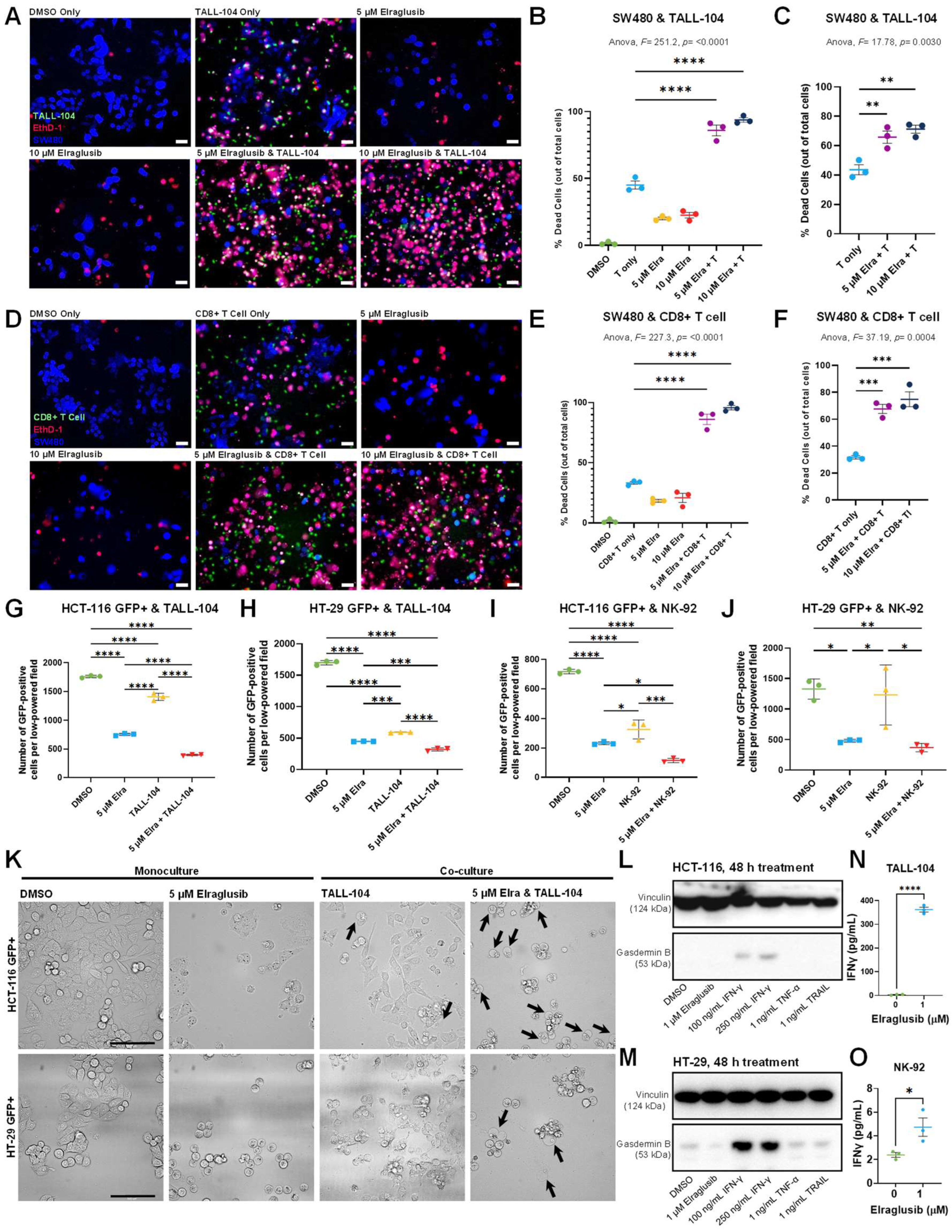
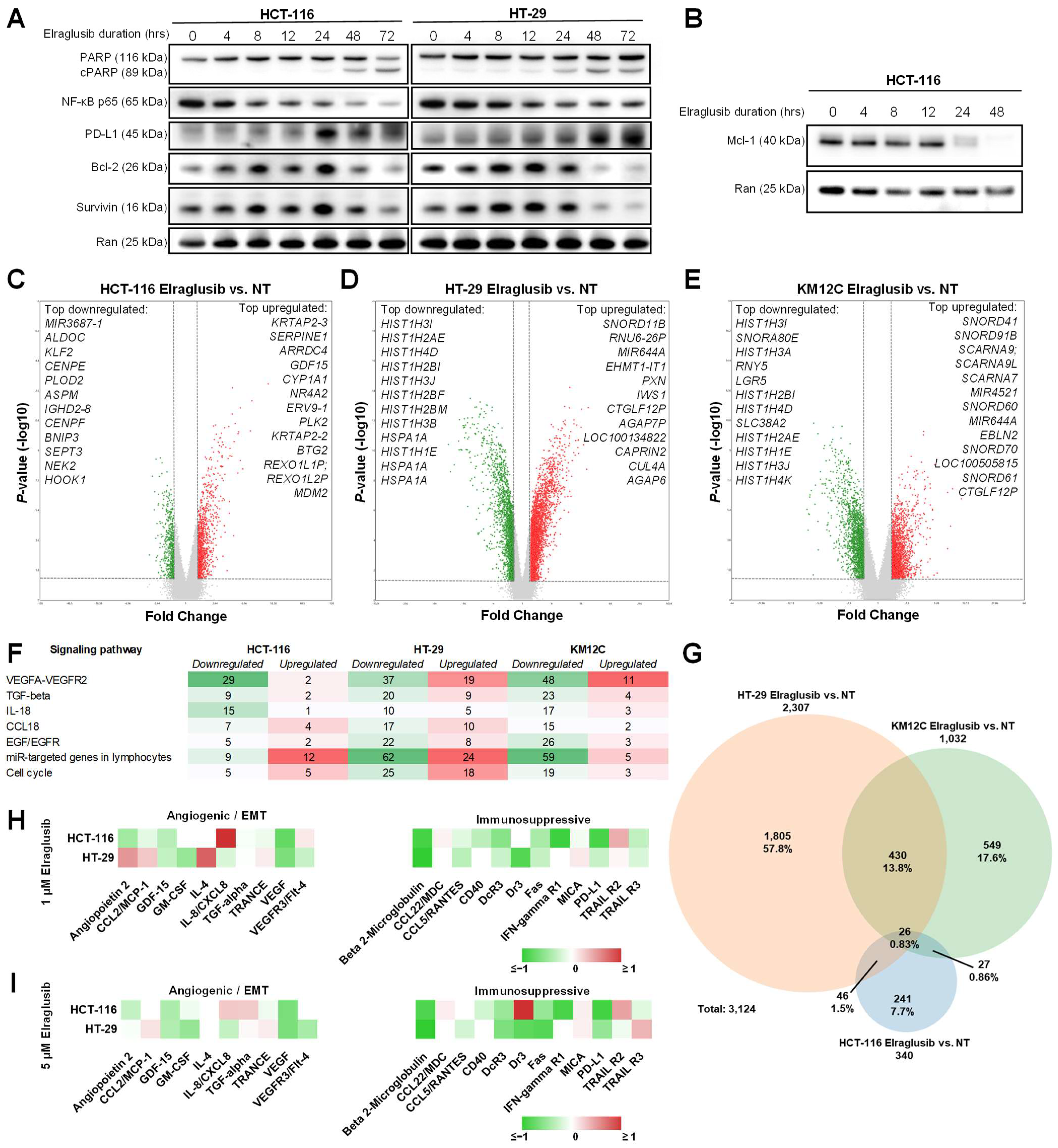
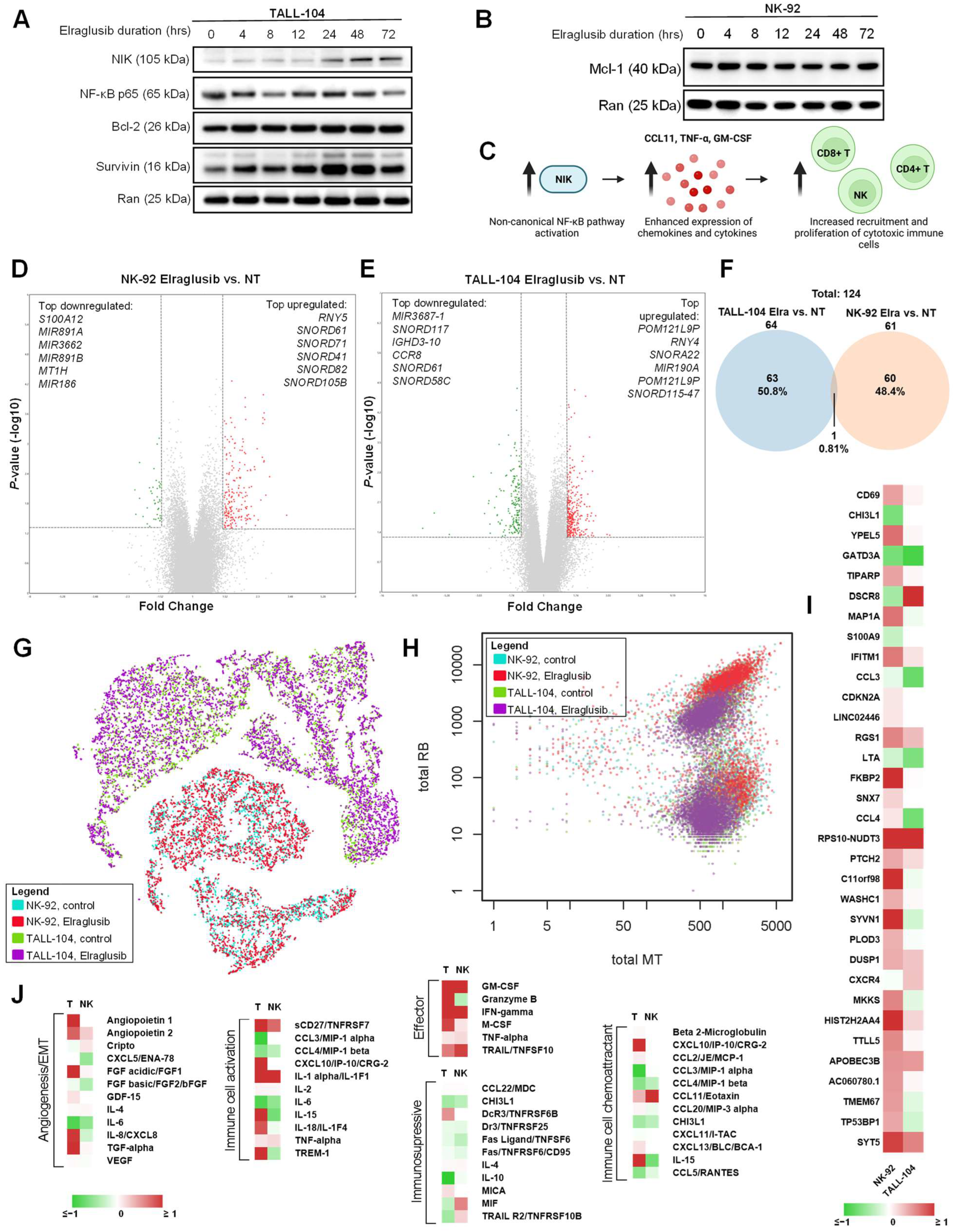
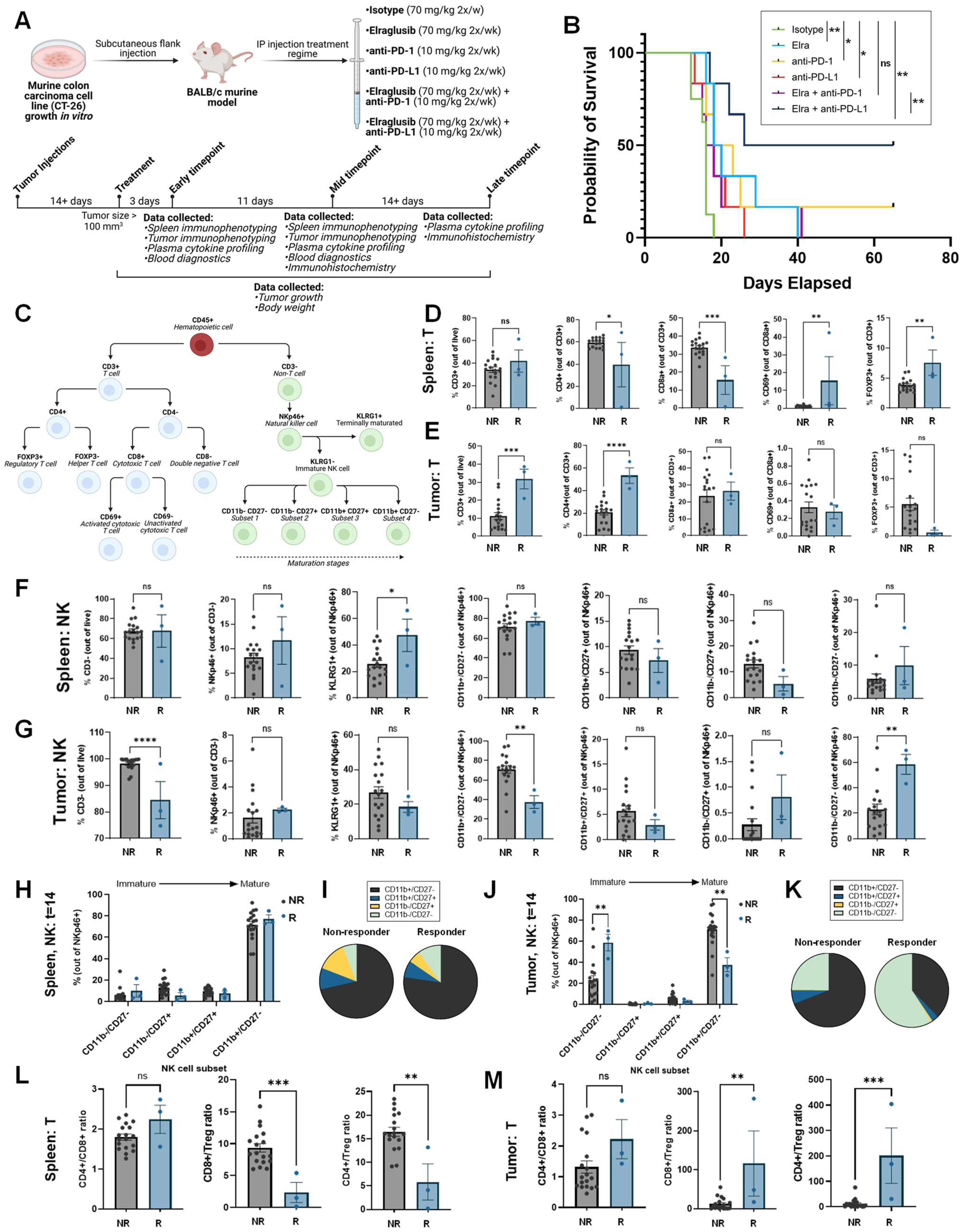
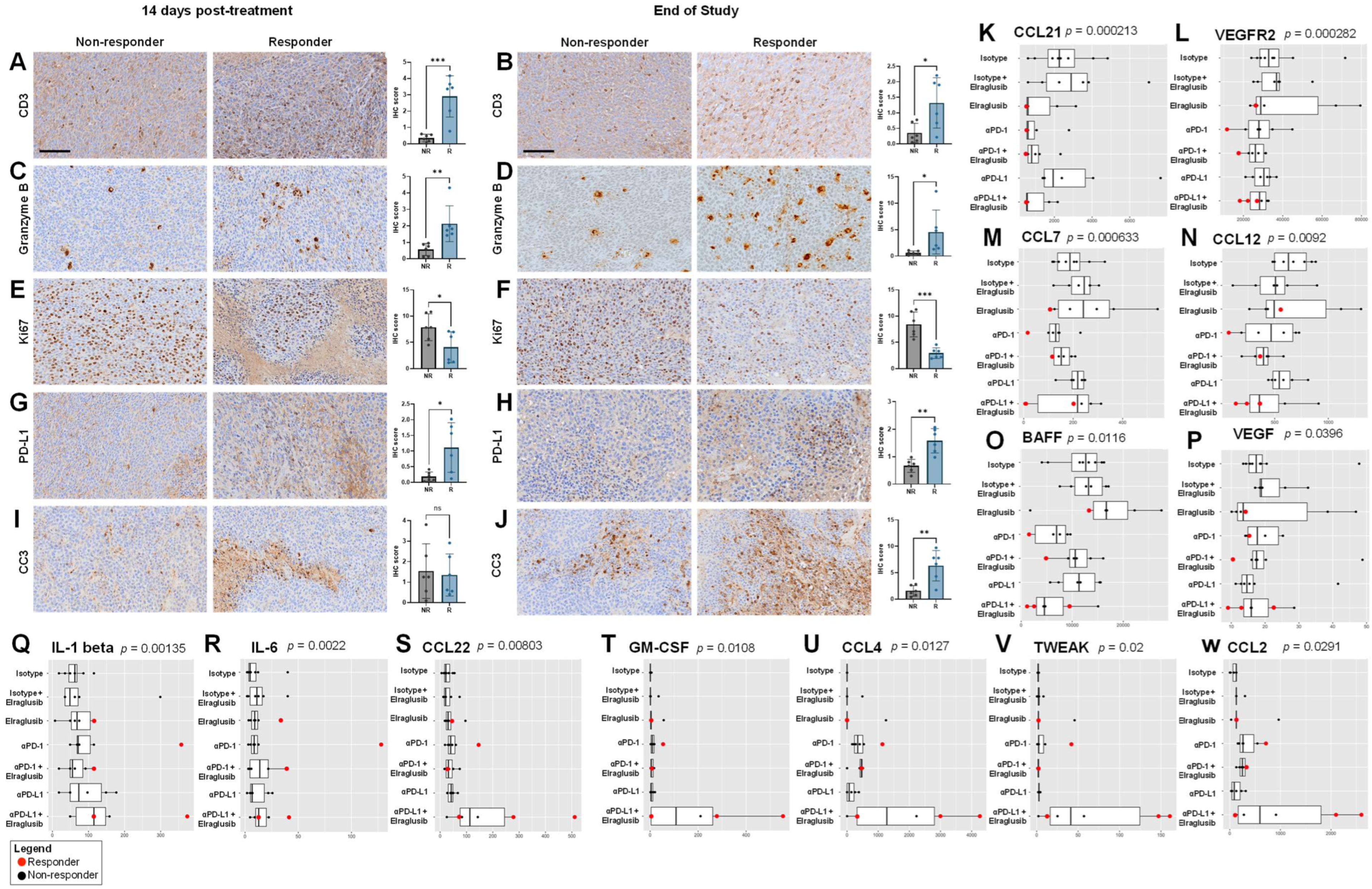
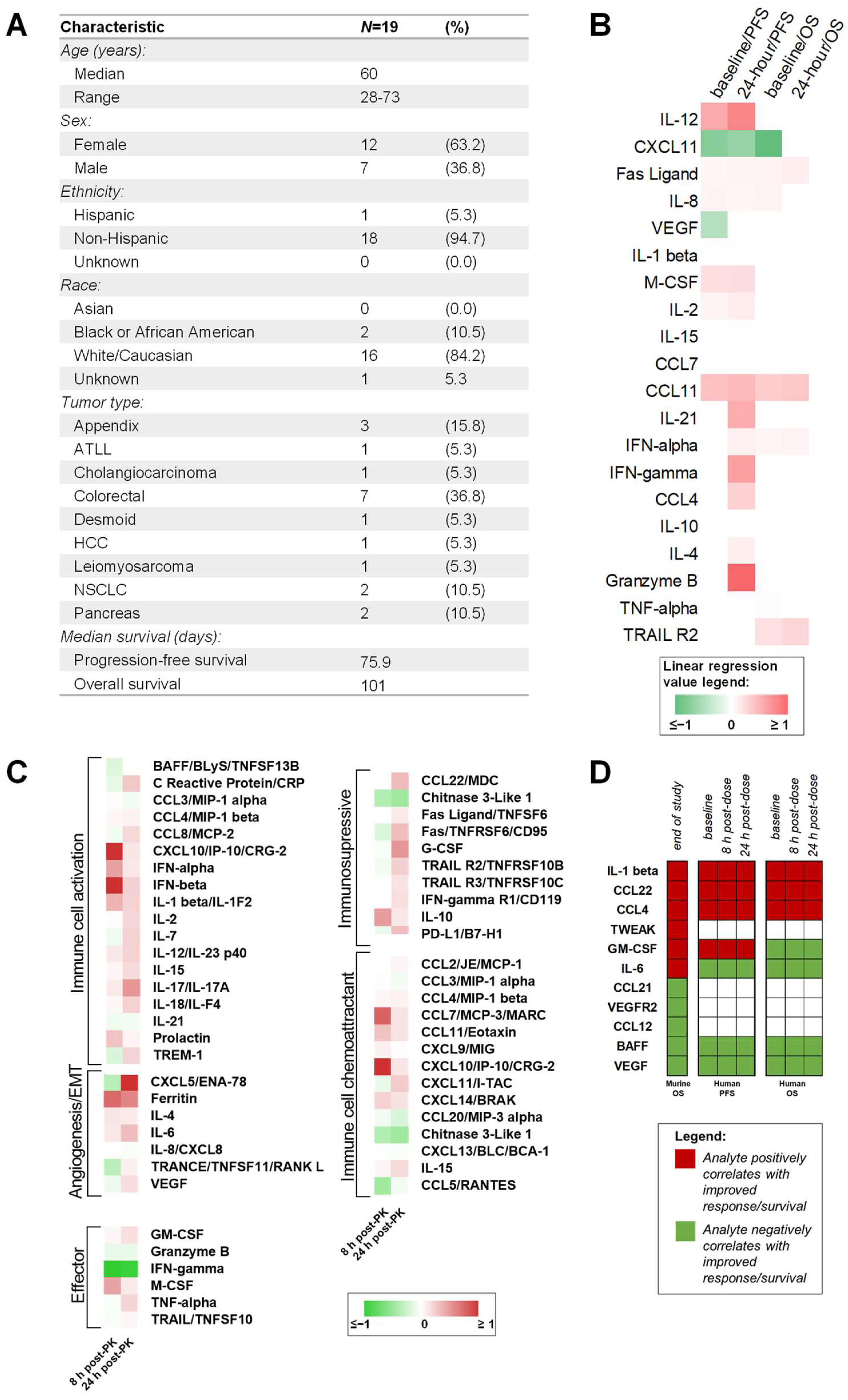
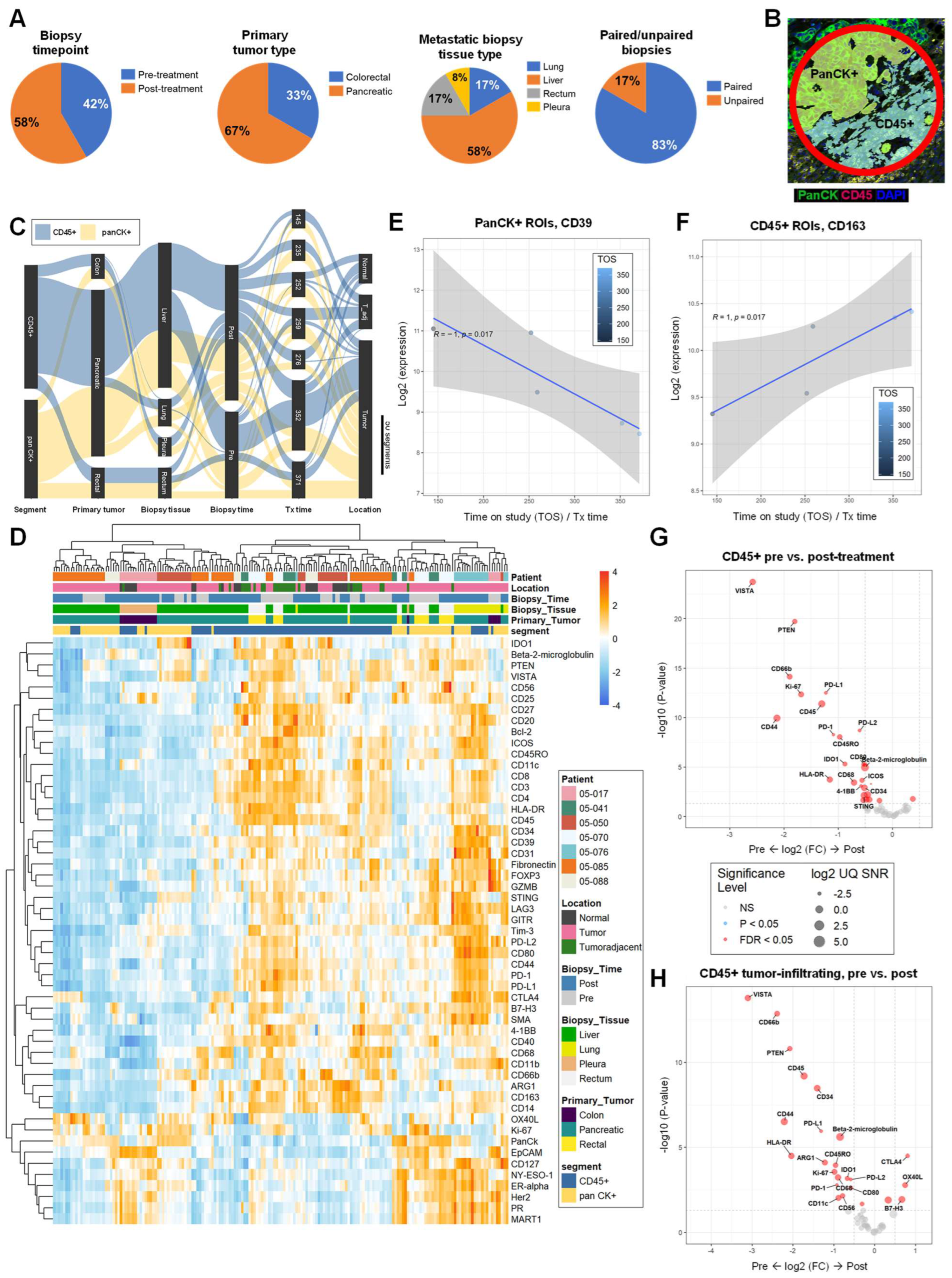
Disclaimer/Publisher’s Note: The statements, opinions and data contained in all publications are solely those of the individual author(s) and contributor(s) and not of MDPI and/or the editor(s). MDPI and/or the editor(s) disclaim responsibility for any injury to people or property resulting from any ideas, methods, instructions or products referred to in the content. |
© 2023 by the authors. Licensee MDPI, Basel, Switzerland. This article is an open access article distributed under the terms and conditions of the Creative Commons Attribution (CC BY) license (https://creativecommons.org/licenses/by/4.0/).
Share and Cite
Huntington, K.E.; Louie, A.D.; Srinivasan, P.R.; Schorl, C.; Lu, S.; Silverberg, D.; Newhouse, D.; Wu, Z.; Zhou, L.; Borden, B.A.; et al. GSK-3 Inhibitor Elraglusib Enhances Tumor-Infiltrating Immune Cell Activation in Tumor Biopsies and Synergizes with Anti-PD-L1 in a Murine Model of Colorectal Cancer. Int. J. Mol. Sci. 2023, 24, 10870. https://doi.org/10.3390/ijms241310870
Huntington KE, Louie AD, Srinivasan PR, Schorl C, Lu S, Silverberg D, Newhouse D, Wu Z, Zhou L, Borden BA, et al. GSK-3 Inhibitor Elraglusib Enhances Tumor-Infiltrating Immune Cell Activation in Tumor Biopsies and Synergizes with Anti-PD-L1 in a Murine Model of Colorectal Cancer. International Journal of Molecular Sciences. 2023; 24(13):10870. https://doi.org/10.3390/ijms241310870
Chicago/Turabian StyleHuntington, Kelsey E., Anna D. Louie, Praveen R. Srinivasan, Christoph Schorl, Shaolei Lu, David Silverberg, Daniel Newhouse, Zhijin Wu, Lanlan Zhou, Brittany A. Borden, and et al. 2023. "GSK-3 Inhibitor Elraglusib Enhances Tumor-Infiltrating Immune Cell Activation in Tumor Biopsies and Synergizes with Anti-PD-L1 in a Murine Model of Colorectal Cancer" International Journal of Molecular Sciences 24, no. 13: 10870. https://doi.org/10.3390/ijms241310870
APA StyleHuntington, K. E., Louie, A. D., Srinivasan, P. R., Schorl, C., Lu, S., Silverberg, D., Newhouse, D., Wu, Z., Zhou, L., Borden, B. A., Giles, F. J., Dooner, M., Carneiro, B. A., & El-Deiry, W. S. (2023). GSK-3 Inhibitor Elraglusib Enhances Tumor-Infiltrating Immune Cell Activation in Tumor Biopsies and Synergizes with Anti-PD-L1 in a Murine Model of Colorectal Cancer. International Journal of Molecular Sciences, 24(13), 10870. https://doi.org/10.3390/ijms241310870








